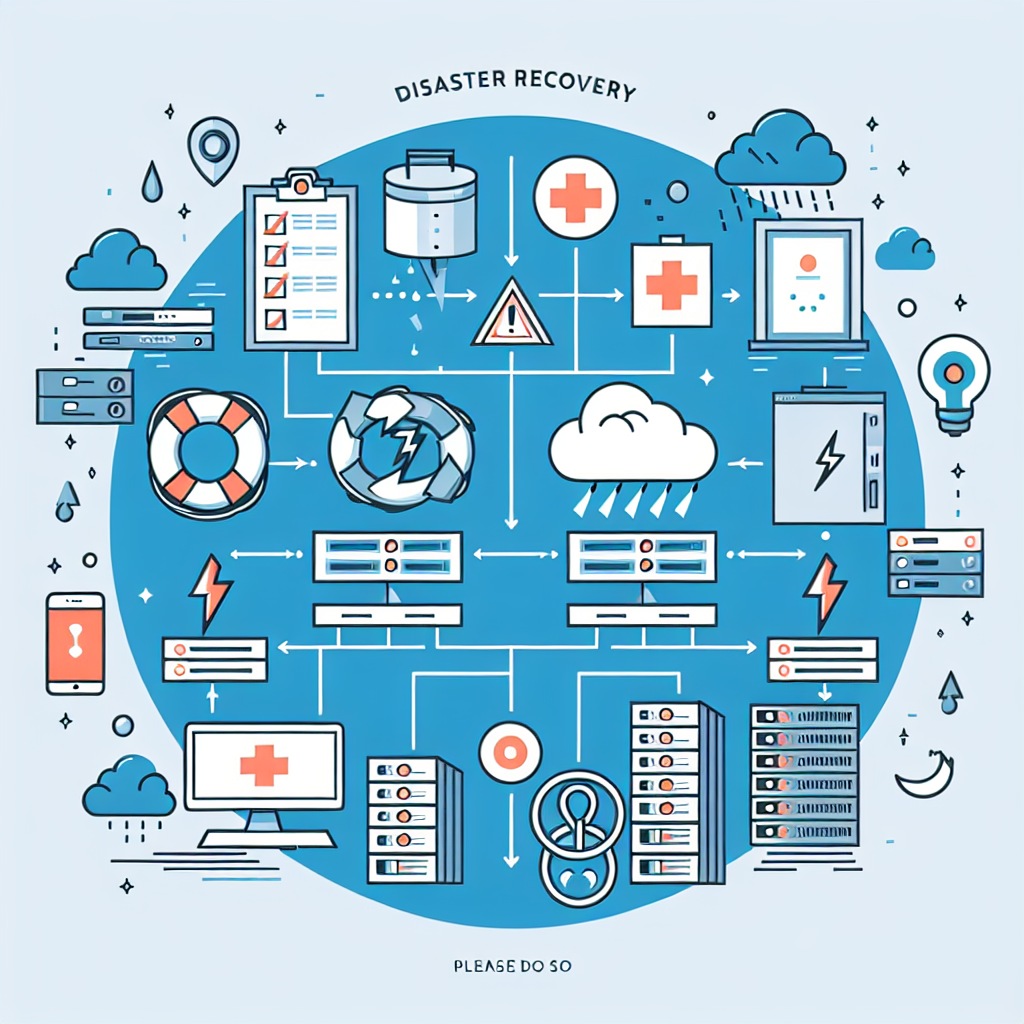Your cart is currently empty!
Tag: Steps

5 Key Steps for Effective Disaster Recovery
Disasters can strike at any time, and it’s crucial for businesses to have a solid disaster recovery plan in place to ensure minimal disruption and downtime. Whether it’s a natural disaster like a hurricane or a man-made disaster such as a cyber attack, being prepared is key to quickly getting back on track. Here are five key steps for effective disaster recovery:1. Identify and assess risks: The first step in effective disaster recovery is to identify and assess potential risks that could impact your business. This includes natural disasters like floods, earthquakes, and wildfires, as well as man-made disasters like cyber attacks, data breaches, and power outages. By understanding the risks your business faces, you can better prepare for them and develop a plan to mitigate their impact.
2. Develop a comprehensive disaster recovery plan: Once you have identified the risks your business faces, it’s important to develop a comprehensive disaster recovery plan that outlines how your business will respond in the event of a disaster. This plan should include detailed processes for data backup and recovery, communication with employees and customers, and steps for resuming normal business operations as quickly as possible.
3. Test your disaster recovery plan regularly: A disaster recovery plan is only effective if it has been thoroughly tested and proven to work. Regularly testing your disaster recovery plan ensures that all processes and procedures are up to date and functioning as intended. This also gives you the opportunity to identify any weaknesses or gaps in your plan and make necessary adjustments.
4. Secure and backup critical data: One of the most important aspects of disaster recovery is ensuring that your critical data is secure and backed up. This includes customer information, financial records, and any other data that is essential to your business operations. By regularly backing up your data to secure offsite locations, you can ensure that it is safe and accessible in the event of a disaster.
5. Communicate and educate employees: In the event of a disaster, clear communication is key to ensuring that everyone knows what to do and where to go. Make sure that all employees are aware of the disaster recovery plan and their roles and responsibilities in implementing it. Regular training and education on disaster preparedness can help employees feel more confident and prepared in the event of an emergency.
In conclusion, effective disaster recovery requires careful planning, regular testing, and clear communication. By following these key steps, businesses can minimize the impact of disasters and quickly get back up and running. Remember, it’s not a matter of if a disaster will strike, but when – so be prepared.

6 Steps to Creating an Effective Business Continuity Plan
In today’s fast-paced and unpredictable business environment, having a solid business continuity plan is essential for any organization. A business continuity plan outlines the steps that need to be taken in the event of a disruption to ensure that critical operations can continue and that the organization can quickly recover.Here are six steps to creating an effective business continuity plan:
1. Identify key business processes and resources: The first step in creating a business continuity plan is to identify the key processes and resources that are essential for the operation of your organization. This could include things like IT systems, key personnel, and critical suppliers.
2. Conduct a risk assessment: Once you have identified your key processes and resources, the next step is to conduct a risk assessment to identify potential threats to your organization. This could include natural disasters, cyber attacks, or other disruptions that could impact your business.
3. Develop a response strategy: Based on the results of your risk assessment, you should develop a response strategy that outlines how your organization will respond to different types of disruptions. This could include things like having backup systems in place, establishing communication protocols, and identifying alternate suppliers.
4. Create a communication plan: Communication is key during a business disruption, so it’s important to have a communication plan in place. This should outline how you will communicate with employees, customers, suppliers, and other key stakeholders during a disruption.
5. Test your plan: Once you have developed your business continuity plan, it’s important to test it to ensure that it will be effective in a real-life scenario. This could involve conducting tabletop exercises or simulations to identify any weaknesses in your plan.
6. Review and update your plan regularly: Finally, it’s important to regularly review and update your business continuity plan to ensure that it remains current and effective. As your organization grows and changes, so too will the potential risks that it faces, so it’s important to regularly reassess your plan and make any necessary updates.
In conclusion, creating an effective business continuity plan is essential for any organization looking to protect its critical operations and quickly recover from disruptions. By following these six steps, you can create a plan that will help your organization weather any storm and emerge stronger on the other side.

10 Essential Steps for Creating an Effective Disaster Recovery Plan
Disasters can strike at any moment, whether it be a natural disaster like a hurricane or earthquake, or a man-made disaster like a cyber attack or data breach. That’s why it’s crucial for businesses to have a disaster recovery plan in place to ensure they can quickly recover and resume operations after a disaster. Here are 10 essential steps for creating an effective disaster recovery plan:1. Identify potential risks: The first step in creating a disaster recovery plan is to identify the potential risks that your business faces. This could include natural disasters, cyber attacks, power outages, or any other events that could disrupt your business operations.
2. Assess the impact: Once you have identified the potential risks, it’s important to assess the impact that each of these risks could have on your business. This will help you prioritize which risks to focus on in your disaster recovery plan.
3. Define recovery objectives: Next, you should define the recovery objectives for your business. This includes setting goals for how quickly you want to be able to recover and resume operations after a disaster.
4. Create a communication plan: A key component of any disaster recovery plan is a communication plan. This should outline how you will communicate with employees, customers, and other stakeholders during and after a disaster.
5. Backup critical data: Make sure to regularly back up critical data and store it in a secure location. This will ensure that you can quickly recover important information in the event of a disaster.
6. Develop a recovery strategy: Once you have identified the risks, assessed the impact, and defined your recovery objectives, it’s time to develop a recovery strategy. This should outline the steps you will take to recover and resume operations after a disaster.
7. Train employees: It’s important to train employees on the disaster recovery plan and their roles and responsibilities in the event of a disaster. This will ensure that everyone knows what to do when a disaster strikes.
8. Test the plan: Regularly test your disaster recovery plan to ensure that it is effective and up to date. This will help you identify any weaknesses or gaps in the plan so you can address them before a disaster occurs.
9. Update the plan: As your business grows and changes, so too should your disaster recovery plan. Make sure to regularly review and update the plan to account for any new risks or changes in your business operations.
10. Review and improve: Finally, it’s important to regularly review and improve your disaster recovery plan. This will help ensure that your plan remains effective and that your business is prepared to quickly recover and resume operations after a disaster.
In conclusion, creating an effective disaster recovery plan is crucial for businesses to ensure they can quickly recover and resume operations after a disaster. By following these 10 essential steps, businesses can create a comprehensive disaster recovery plan that will help them mitigate risks and minimize the impact of disasters on their operations.

The Key Steps to Implementing a Successful Proactive Maintenance Program
Proactive maintenance is a strategy that involves taking preventative measures to keep equipment and machinery in optimal working condition. By implementing a proactive maintenance program, businesses can reduce downtime, extend the lifespan of their assets, and save money on costly repairs.There are several key steps to implementing a successful proactive maintenance program. These steps include:
1. Conducting a thorough assessment: Before implementing a proactive maintenance program, it is important to conduct a thorough assessment of your equipment and machinery. This will help you identify any potential issues or areas that may need attention. By understanding the current state of your assets, you can develop a targeted maintenance plan.
2. Creating a maintenance schedule: Once you have assessed your equipment, it is important to create a maintenance schedule that outlines when each asset needs to be serviced. This schedule should include regular inspections, cleaning, and lubrication to ensure that your equipment is operating at peak performance.
3. Training your staff: It is essential to train your staff on the importance of proactive maintenance and how to properly carry out maintenance tasks. By educating your team on best practices, you can ensure that your equipment is properly maintained and that any potential issues are identified early on.
4. Utilizing technology: Technology can play a crucial role in implementing a successful proactive maintenance program. By using tools such as predictive maintenance software and sensors, you can monitor the health of your equipment in real-time and identify potential issues before they become major problems.
5. Tracking and analyzing data: In order to continuously improve your proactive maintenance program, it is important to track and analyze data on equipment performance and maintenance activities. By monitoring key performance indicators and analyzing trends, you can identify areas for improvement and make adjustments to your maintenance plan as needed.
6. Continuous improvement: Finally, it is important to continuously evaluate and improve your proactive maintenance program. By seeking feedback from your staff, monitoring the effectiveness of your maintenance activities, and making adjustments as needed, you can ensure that your program is successful in keeping your equipment running smoothly.
In conclusion, implementing a successful proactive maintenance program requires careful planning, training, and the use of technology. By following these key steps, businesses can ensure that their equipment is well-maintained and that costly downtime is minimized.

10 Key Steps for Implementing an Effective Disaster Recovery Plan
Disasters can strike at any time, and it’s essential for businesses to have a well-thought-out disaster recovery plan in place to ensure minimal downtime and data loss. Implementing an effective disaster recovery plan involves careful planning and execution. Here are 10 key steps to help you create and implement a successful disaster recovery plan for your business:1. Identify potential risks: The first step in creating a disaster recovery plan is to identify the potential risks that could impact your business. These risks could include natural disasters such as floods, hurricanes, fires, or man-made disasters like cyber-attacks, power outages, or equipment failures.
2. Assess critical assets and processes: Determine which assets and processes are critical to your business operations. This could include customer data, financial records, or key applications. Prioritize these assets and processes based on their importance to the business.
3. Set recovery objectives: Define your recovery objectives, including recovery time objectives (RTO) and recovery point objectives (RPO). RTO specifies the maximum allowable downtime for your systems, while RPO determines how much data loss is acceptable.
4. Develop a detailed plan: Create a comprehensive disaster recovery plan that outlines the steps to be taken in the event of a disaster. Include contact information for key personnel, vendors, and emergency services, as well as detailed instructions for restoring critical systems and data.
5. Test your plan: Regularly test your disaster recovery plan to ensure it is effective and up to date. Conduct tabletop exercises or simulated disaster scenarios to identify any weaknesses in your plan and make necessary adjustments.
6. Train employees: Ensure all employees are trained on the disaster recovery plan and their roles and responsibilities in the event of a disaster. Regular training and drills will help ensure a swift and coordinated response when disaster strikes.
7. Implement backup and recovery solutions: Implement a reliable backup and recovery solution to protect your critical data and systems. Consider using cloud-based backup services or offsite storage to ensure data is securely stored and easily accessible in the event of a disaster.
8. Establish communication protocols: Develop communication protocols to keep employees, customers, and stakeholders informed during a disaster. Have a designated spokesperson and multiple communication channels in place to ensure timely and accurate updates.
9. Monitor and update the plan: Regularly monitor and update your disaster recovery plan to reflect changes in your business operations, technology, or potential risks. Conduct regular reviews and audits to ensure the plan remains effective and responsive to evolving threats.
10. Review and learn from past incidents: After a disaster or incident, conduct a post-mortem analysis to identify what worked well and areas for improvement. Use this feedback to update and enhance your disaster recovery plan for future incidents.
By following these 10 key steps, businesses can create and implement an effective disaster recovery plan that will help minimize downtime, data loss, and financial impact in the event of a disaster. Planning and preparation are essential to ensure your business can recover quickly and continue operations in the face of unexpected disruptions.

Cybersecurity for Small Businesses: Essential Steps to Protect Your Company
In today’s digital age, cybersecurity is more important than ever for small businesses. With the rise of cyber threats such as data breaches, ransomware attacks, and phishing scams, it’s crucial for small businesses to take proactive steps to protect their company and sensitive data.Here are some essential steps that small businesses can take to enhance their cybersecurity measures:
1. Implement strong password policies: One of the simplest yet most effective ways to protect your company’s data is to enforce strong password policies. Encourage employees to use complex passwords that include a combination of letters, numbers, and special characters. Additionally, consider implementing multi-factor authentication for an extra layer of security.
2. Keep software up to date: Regularly updating software and operating systems is essential for protecting your business from security vulnerabilities. Hackers often exploit outdated software to gain access to company networks, so make sure to install updates as soon as they become available.
3. Train employees on cybersecurity best practices: Human error is one of the leading causes of cybersecurity breaches, so it’s important to educate your employees on how to spot phishing emails, avoid clicking on suspicious links, and recognize potential security threats. Consider conducting regular cybersecurity training sessions to keep your team informed and vigilant.
4. Backup data regularly: In the event of a ransomware attack or data breach, having regularly backed up data can help your business recover quickly and minimize the impact of the incident. Make sure to store backups securely and test them regularly to ensure they are up to date and accessible when needed.
5. Secure your network: Implementing firewalls, antivirus software, and intrusion detection systems can help protect your network from potential cyber threats. Consider working with a cybersecurity provider to conduct regular network assessments and identify any vulnerabilities that need to be addressed.
6. Limit access to sensitive data: Not all employees need access to sensitive data, so it’s important to restrict access to only those who require it to perform their job duties. Implement role-based access controls to ensure that employees only have access to the information they need to do their job effectively.
7. Create an incident response plan: Despite taking all necessary precautions, cybersecurity incidents can still occur. Having an incident response plan in place can help your business respond quickly and effectively in the event of a security breach. Make sure to regularly review and update your plan to ensure it remains current and effective.
By taking these essential steps to protect your company, small businesses can enhance their cybersecurity measures and reduce the risk of falling victim to cyber threats. Remember that investing in cybersecurity is an investment in the future success and security of your business.

10 Essential Steps for Effective Disaster Recovery Planning
Disasters can strike at any time, whether it be a natural disaster like a hurricane or earthquake, or a man-made disaster like a cyberattack or data breach. In order to ensure that your business is prepared to handle any disaster that comes its way, it is essential to have a solid disaster recovery plan in place. Here are 10 essential steps for effective disaster recovery planning:1. Identify potential risks: The first step in disaster recovery planning is to identify the potential risks that your business may face. This includes natural disasters, cyberattacks, data breaches, and other potential threats.
2. Assess the impact: Once you have identified the potential risks, it is important to assess the potential impact that each of these risks could have on your business. This will help you prioritize your disaster recovery efforts.
3. Develop a plan: Once you have identified the potential risks and assessed their impact, it is time to develop a comprehensive disaster recovery plan. This plan should outline the steps that need to be taken in the event of a disaster, including who is responsible for what tasks and how communication will be handled.
4. Test the plan: Once you have developed your disaster recovery plan, it is important to test it regularly to ensure that it is effective. This may involve running simulated disaster scenarios or conducting tabletop exercises with key stakeholders.
5. Backup data regularly: One of the most important aspects of disaster recovery planning is to regularly backup your data. This will ensure that you can quickly recover your data in the event of a disaster.
6. Secure your data: In addition to backing up your data, it is important to secure it as well. This may involve encrypting sensitive data, implementing access controls, and regularly monitoring for unauthorized access.
7. Establish communication protocols: Communication is key during a disaster, so it is important to establish communication protocols in advance. This may include setting up emergency communication channels, creating contact lists, and establishing a chain of command.
8. Train employees: Your employees are a key part of your disaster recovery plan, so it is important to train them on what to do in the event of a disaster. This may involve conducting regular training sessions or providing employees with written instructions.
9. Review and update the plan regularly: Disaster recovery planning is an ongoing process, so it is important to regularly review and update your plan as needed. This may involve incorporating lessons learned from past disasters or making adjustments based on changes in your business operations.
10. Coordinate with external partners: Finally, it is important to coordinate with external partners, such as vendors, customers, and emergency services, as part of your disaster recovery planning. This will help ensure that everyone is on the same page and can work together effectively in the event of a disaster.
By following these 10 essential steps for effective disaster recovery planning, you can help ensure that your business is prepared to handle any disaster that comes its way. Remember, the key to effective disaster recovery planning is preparation and communication, so take the time to develop a comprehensive plan that will help protect your business in the event of a disaster.

10 Essential Steps for Effective Disaster Recovery
Disasters can strike at any time, whether it be a natural disaster like a hurricane or a man-made disaster like a cyber attack. In order to ensure that your business can recover quickly and effectively in the event of a disaster, it is important to have a solid disaster recovery plan in place. Here are 10 essential steps for effective disaster recovery:1. Identify potential risks: The first step in creating a disaster recovery plan is to identify the potential risks that your business may face. This could include natural disasters, such as floods or earthquakes, as well as man-made disasters like cyber attacks or power outages.
2. Assess the impact: Once you have identified the potential risks, it is important to assess the potential impact that these disasters could have on your business. This will help you prioritize your recovery efforts and allocate resources accordingly.
3. Develop a plan: Based on your risk assessment, develop a comprehensive disaster recovery plan that outlines the steps that need to be taken in the event of a disaster. This plan should include contact information for key personnel, backup procedures, and recovery timelines.
4. Test the plan: It is important to regularly test your disaster recovery plan to ensure that it is effective. This could involve conducting mock disaster scenarios or testing backup systems to ensure that they are functioning properly.
5. Train employees: Make sure that all employees are aware of the disaster recovery plan and understand their roles and responsibilities in the event of a disaster. Regular training sessions can help ensure that everyone is prepared in case of an emergency.
6. Backup data: One of the most important aspects of disaster recovery is backing up your data. Make sure that all important data is regularly backed up and stored in a secure location. This will ensure that you can quickly recover your data in the event of a disaster.
7. Secure your IT systems: In today’s digital age, many businesses rely heavily on their IT systems. Make sure that your IT systems are secure and protected from cyber attacks. This could involve implementing firewalls, antivirus software, and regular security updates.
8. Communicate with stakeholders: In the event of a disaster, it is important to communicate with stakeholders, including employees, customers, and suppliers. Keep them informed of the situation and provide updates on your recovery efforts.
9. Coordinate with emergency services: If a disaster strikes, it is important to coordinate with emergency services to ensure the safety of your employees and customers. Make sure that you have emergency contact information readily available and that you have a plan in place to evacuate your premises if necessary.
10. Review and update the plan: Finally, it is important to regularly review and update your disaster recovery plan to ensure that it remains effective. As your business grows and evolves, your disaster recovery plan should be updated to reflect any changes in your operations.
By following these 10 essential steps for effective disaster recovery, you can ensure that your business is prepared to recover quickly and effectively in the event of a disaster. Remember, it is always better to be proactive and prepared than to be caught off guard in an emergency situation.
Royce O’Neale steps up as starter in Suns’ win vs Harden, Clippers
Phoenix Suns coach Mike Budenholzer could’ve easily given the starting nod to Bradley Beal for their 111-109 home win against the Los Angeles Clippers on Monday.
Prior to the game, Budenholzer didn’t reveal who’d replace injured rookie wing Ryan Dunn (left ankle sprain) in the starting lineup. He ultimately rolled with Royce O’Neale instead of Beal.
“He could’ve went with anybody and he chose me,” O’Neale told The Arizona Republic after the game. “Don’t change my mindset. Just play as hard as I can, come in and impact the game and just be me.”
Most observers would have predicted Beal the choice after he scored 20 points in 38 minutes off the bench during Phoenix’s 119-109 home win over Washington on Saturday. He also was a starter up until a few weeks ago, when Budenholzer replaced him with Dunn.
During O’Neale’s 10th start this season Monday, he scored 11 points, hit 3-of-8 from 3 and matched his season-high of four steals against L.A.
Need a break? Play the USA TODAY Daily Crossword Puzzle.
O’Neale is known as a versatile playmaker, tough defender, solid 3-point shooter (Suns’ third-best 40.5% on 5.6 attempts per game) and penetrator. Budenholzer’s plan was to have him stick to James Harden and have Beal back him up with that task and contain Kawhi Leonard.
“He gave us a presence on Harden,” Budeholzer said about O’Neale. “We had a lot of different people we were gonna throw at Harden, but I think starting with Royce and then coming with Brad. I thought Brad did a great job on Harden, did a great job on Kawhi.
“Just trying to keep those same combinations we’ve been talking about. … He and Royce defensively I thought gave us a great presence on Harden and Leonard,” Budenholzer continued.
At the Suns’ Monday shootaround, Tyus Jones said Harden’s recently played “in a really good rhythm.” He’s a high-level scorer and distributor (21.7 points per game, NBA’s sixth-best at 8.3 assists), and dropped 40 and nine in L.A.’s win over Milwaukee on Saturday.
“It’s a group effort, especially on the defense,” O’Neale said about Harden. “I think all of us being connected and talking. We know he likes to hit the pocket pass, or the step-back 3, or attack. So I think just trying to make things tough for him, taking every advantage.”
The same goes for Leonard, who played his eighth game of the season after being sidelined most of the season from his recurring knee injury.
O’Neale and Beal helped limit Harden and Leonard to just eight and four points during the first half, respectively. Harden finished with 24 points, the game-high 10 assists and six rebounds. His other game-high, though, was six turnovers. Leonard ended the game with 17 points and five boards.
Two of O’Neale’s steals and one of Beal’s two steals were off Harden. The Clippers guard’s other early turnover was when Harden had Grayson Allen on an isolation drive, and Allen rotated over to help and pick up a charge on Harden.
O’Neale nearly got what would’ve been his first steal off Harden, and five total, at 7:05 in the first. Harden dribbled at mid-court and O’Neale disrupted his dribble before he initiated an offensive play and they got tied up for a jump-ball.
“When he plays that way picking you up as soon as the ball crosses half-court, using his hands well – always been great with his hands,” Kevin Durant said.
“He’s physical and just plays hard. Sometimes you might be out of position, but if you play hard you get steals, you get blocks, so Royce was great tonight,” Durant added.
O’Neale also set the tone for Phoenix with their 3-point shooting, in which they matched a season-high 22 made from the arc.
He knocked down the Suns’ first triple in the first quarter’s opening minutes, two more in the second. His third trey in the first half’s final minute extended their largest lead to 13.
The Suns have played well in January, edging the Clippers to get eight wins out of their past 10 games.
O’Neale feels that his teammates haven’t been rattled by the media’s trade speculation surrounding Beal and Jimmy Butler, or the frenzy about Budenholzer and the Suns’ former starting center Jusuf Nurkic not talking for two months while he’s on the trading block.
“Never too high, never too low, keep playing and being us,” O’Neale said. “Outside noise is always gonna be outside. I think we just focused on each other, try to win as many games as we can. That’s what it’s about.”
In a thrilling matchup against James Harden and the LA Clippers, Royce O’Neale proved his worth as a starter for the Phoenix Suns. O’Neale’s impressive performance helped lead the Suns to a crucial victory, showcasing his ability to step up in high-pressure situations.The game was a back-and-forth battle from start to finish, with both teams trading baskets and momentum swings. O’Neale’s defensive prowess was on full display as he locked down Harden, one of the league’s most prolific scorers, and limited his impact on the game. His tenacity on the defensive end sparked the Suns’ energy and helped set the tone for the team’s overall performance.
Offensively, O’Neale also made his presence felt, knocking down key shots and making smart plays to keep the Suns in control of the game. His ability to contribute on both ends of the floor was crucial in securing the win for Phoenix, as they continue to solidify their position as a top contender in the Western Conference.
As O’Neale continues to excel in his role as a starter for the Suns, his contributions will be vital to the team’s success moving forward. His performance against Harden and the Clippers serves as a reminder of his value to the team and his ability to rise to the occasion in big moments. Suns fans can rest assured knowing that O’Neale is more than capable of stepping up when his team needs him most.
Tags:
Royce O’Neale, Suns, starter, win, Harden, Clippers, NBA, basketball, game, performance, highlights
#Royce #ONeale #steps #starter #Suns #win #Harden #Clippers
Preparing for the Unexpected: Key Steps for Business Continuity
In today’s fast-paced and ever-changing business world, it is essential for companies to be prepared for the unexpected. Whether it be a natural disaster, a cyber attack, or a global pandemic, having a solid business continuity plan in place can mean the difference between survival and failure.Here are some key steps that every business should take to ensure they are prepared for the unexpected:
1. Conduct a risk assessment: The first step in developing a business continuity plan is to identify potential risks and threats to your business. This could include natural disasters, cyber attacks, supply chain disruptions, or even a pandemic. By conducting a thorough risk assessment, you can better understand what threats your business may face and develop a plan to mitigate them.
2. Develop a business continuity plan: Once you have identified the potential risks to your business, it is important to develop a comprehensive business continuity plan. This plan should outline the steps that your company will take in the event of a disaster or emergency, including how you will communicate with employees, customers, and suppliers, how you will continue operations, and how you will recover and resume normal business activities.
3. Test your plan: A business continuity plan is only effective if it is regularly tested and updated. Conducting regular drills and simulations can help ensure that your plan is effective and that your employees are prepared to respond in the event of an emergency. Additionally, it is important to review and update your plan regularly to account for any changes in your business or the external environment.
4. Communicate with stakeholders: In the event of a disaster or emergency, clear and effective communication is essential. Make sure that you have a plan in place for how you will communicate with employees, customers, suppliers, and other stakeholders in the event of an emergency. This could include setting up a communication hotline, establishing an emergency contact list, or using social media and other channels to keep stakeholders informed.
5. Backup your data: In today’s digital age, data is one of the most valuable assets of any business. To ensure that your business can continue to operate in the event of a disaster, it is essential to regularly backup your data and store it in a secure location. This will help ensure that you can quickly recover and resume operations in the event of a data loss or breach.
By taking these key steps to prepare for the unexpected, businesses can better protect themselves from potential risks and ensure that they are able to continue operating in the face of adversity. A solid business continuity plan can provide peace of mind to business owners and employees alike, knowing that they are prepared for whatever challenges may come their way.

